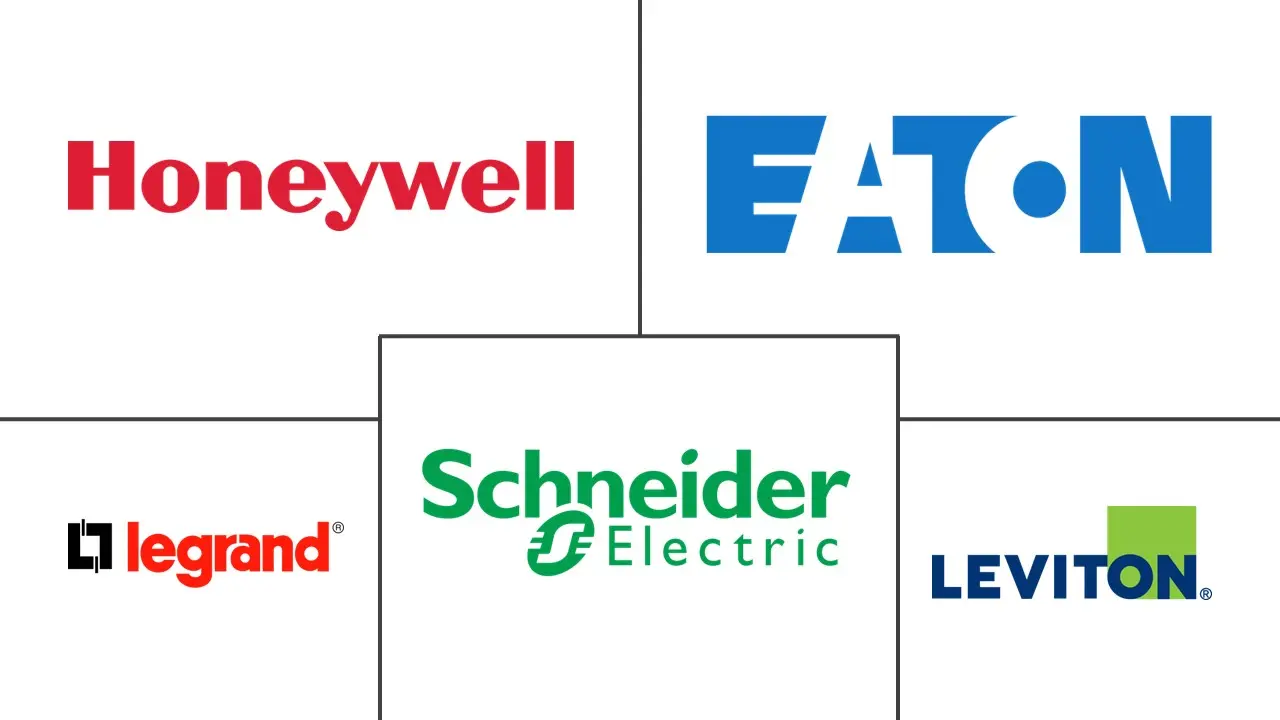Occupancy Tracking Market Size
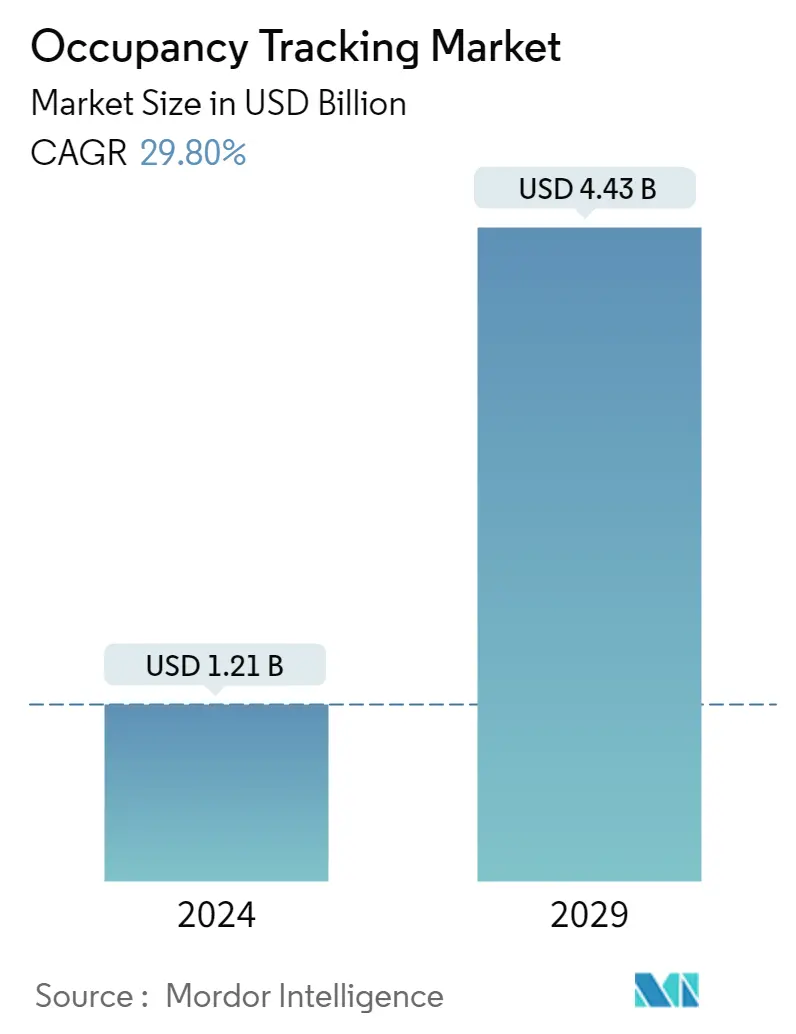
| Study Period | 2019 - 2029 |
| Market Size (2024) | USD 1.21 Billion |
| Market Size (2029) | USD 4.43 Billion |
| CAGR (2024 - 2029) | 29.80 % |
| Fastest Growing Market | Asia Pacific |
| Largest Market | Asia Pacific |
Major Players*Disclaimer: Major Players sorted in no particular order |
Occupancy Tracking Market Analysis
The Occupancy Tracking Market size is estimated at USD 1.21 billion in 2024, and is expected to reach USD 4.43 billion by 2029, growing at a CAGR of 29.80% during the forecast period (2024-2029).
The increasing need to monitor actual space usage and target reduction efforts to lower energy consumption as well as meet decarbonization and sustainability goals by various building owners drove market growth in the forecast period.
- The occupancy tracking technologies help businesses meet their ongoing goals of using only suitable building space to keep costs low and operate efficiently. Occupancy monitoring sensors are essential for anyone wanting to manage their buildings smartly and more efficiently.
- Many associations waste as much as half their space. In other words, their preservation potential is vast. According to a World Green Building Study, European businesses could save USD 243 billion by reducing wasted space in office buildings. In addition, businesses globally could realize savings of up to USD 1.5 trillion if workspaces were optimized. Other sources suggest that, on average, desks and offices sit unused about two-thirds of the time in North America. And a Herman Miller space utilization study found that, on average, assigned private offices are unoccupied 77% of the workday.
- The rising demand for energy-efficient devices will drive the studied market's growth. Occupancy tracking plays a vital role in reducing energy consumption. This is achieved through the occupancy sensors, which shut down devices and other equipment based on occupancy. These help reduce light pollution and can be used in indoor and outdoor spaces. For instance, in the US, lighting accounts for 11% of a building's overall energy use, with HVAC systems consuming 35%. US commercial buildings account for around 36% of all electricity use. This energy use is often considered an unavoidable expense. However, much of this energy is wasted every day. Countless businesses pay to heat, cool, and illuminate unoccupied rooms.
- The growing investment in developing smart houses, enterprise buildings, factories, and cities will drive the market forward in the forecasted period. As part of the Digital India initiative, the Indian government has planned to push IoT in the country. The government allocated an INR 7,000 crore fund to develop 100 smart cities powered by IoT appliances to control traffic, efficiently use power and water, and collect data using IoT sensors for healthcare and other services.
- Furthermore, the primary task of building management systems is to control active and passive strategies in buildings to optimize energy efficiency and maintain occupant comfort. However, most of these systems use a predefined configuration, which usually does not match the occupants preferences. Thus, occupancy tracking is imperative for energy use management, mainly in residential and industrial buildings.
- In a survey done in October 2022, 85% of customers of an occupancy technology company, Occuspace, reported using the data to gauge the use of their physical spaces. Further, Vanderbilt University reported an overwhelmingly positive response from students using the Waitz app to navigate busy times in the dining halls and libraries. In addition to Vanderbilt, Occuspace technology has recently been installed at Purdue, Columbia, UCLA, and several others.
- Although the pandemic drove a flurry of interest and investments in occupancy tracking in the near term, there were indications that the need for the technology would remain. Some of the regulations and guidelines are likely to endure in some form, as they have raised awareness about healthy spaces and safeguarded against future pandemics. Moreover, the shift to working from home and pandemic-driven financial headwinds have companies questioning the need for physical office space. Even before the pandemic, U.S. Commercial Real Estate Services estimated unused commercial property in the U.S. to be worth about USD 1 trillion.
Occupancy Tracking Market Trends
Increase in Office Building Space to Drive the Building Type Segment
- Occupancy tracking sensors are deployed in reception areas, meeting rooms, shop floors, or an entire office complex. Occupancy tracking systems provide valuable insight into how spaces are used. This insight enables better decision-making regarding the distribution of space, staff, and resources, helping companies run more efficiently and safely.
- In addition, these sensors are used in offices to efficiently manage space utilization, meeting room efficiency, and desk hoteling, among many others, by installing them in multiple strategic locations to detect motion in high-traffic areas.
- Many occupancy sensor manufacturers are actively pursuing strategic alliances to improve the user experience. In January 2022, Sensative, a Sweden-based global IoT solutions provider, and Actility, a significantly low-power wide area network connectivity solutions provider for IoTs, entered into a collaborative relationship. Along with joint work with WMW. The former has launched an integrated LoRaWAN-enabled IoT desk occupancy monitoring solution through this collaboration. To monitor desks, this solution employs an active infrared sensor.
- Increasing office space across regions may further propel the demand for occupancy tracking solutions in the market. According to the Office for National Statistics (UK), the value of new office building construction orders in the first quarter of 2023 was over USD 2.6 billion for both public and private offices combined.
- In addition, according to Colliers International, in the second quarter of 2022, the Northeast region held the most office space under construction in the United States. There were around 30 million square feet of office space under construction in the Northeast region.
- In the post-COVID-19 era, many Fortune 100 companies adopted the hybrid work model, which became commonplace across different industries. But as of March 2023, tech giants like Amazon and Apple have announced policies that require their employees to come into the office three times a week. This was an expected push for a great return to the office. Due to such dynamic changes, office occupancy rates fluctuated every week, while in those workplaces with a hot desk system, desk occupancy rates may even change daily. Such cases may further create demand for occupancy tracking in office areas.
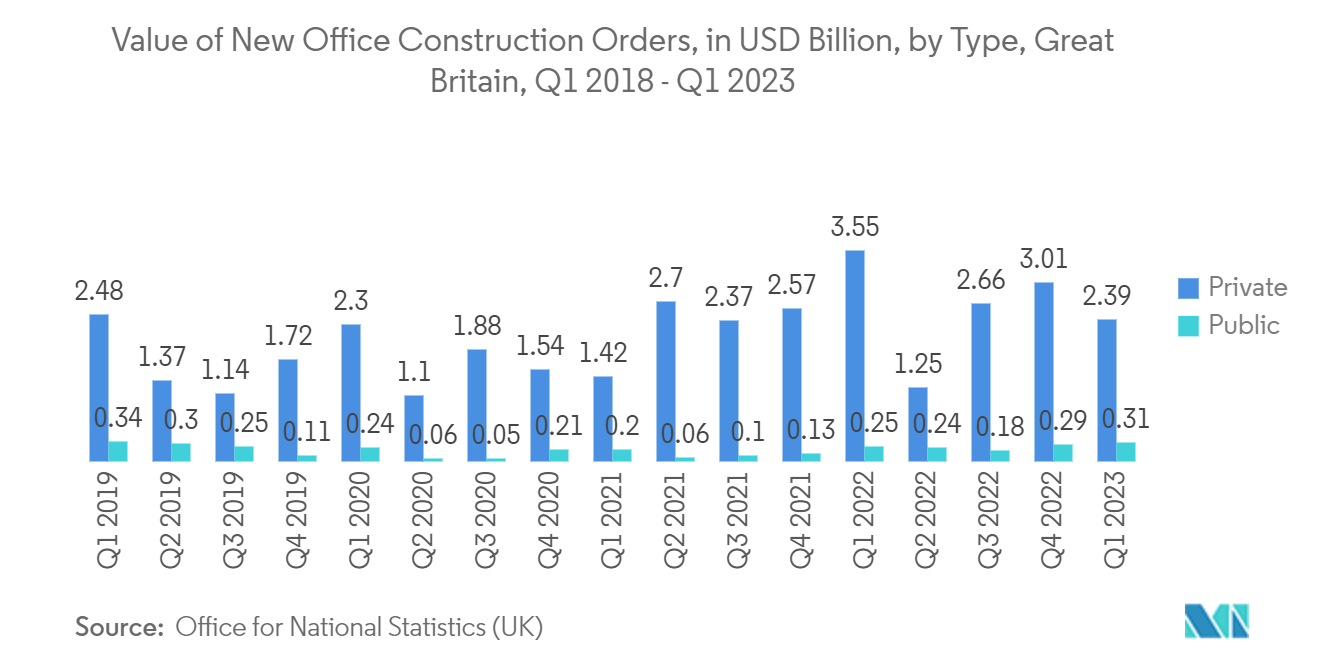
Asia-Pacific to Experience Significant Market Growth
- Asia-Pacific is expected to have significant growth in occupancy tracking solutions during the forecast period due to the increased construction activity in the region. According to IBEF, the Dubai government and India recently signed a contract to construct infrastructure in Jammu and Kashmir, including industrial parks, IT towers, multipurpose towers, logistics centers, medical colleges, and specialized hospitals.
- Additionally, according to the National Bureau of Statistics of China, recently there were over 27,700 hotel enterprises in China, which was a boost of nearly 2,500 enterprises compared to the previous year. The number of large hotel groups in China has grown immensely in the past three years. Such developments in hotels and restaurants may further create demand in the studied market.
- The region includes significant countries such as India and China, which have the majority of energy-consuming countries worldwide. According to BP plc, China is the world's largest consumer of primary energy. The primary energy consumption of China amounted to some 157.7 exajoules recently, an increase of nearly 7% compared to the previous year.
- Furthermore, the Ministry of Land, Infrastructure, and Transport of the South Korean government announced its initiative to develop smart city platforms across 64 selected medium- and small-sized cities by 2022 through a state project worth USD 25 million. Similar outcomes being deployed in other parts of the world are increasing the demand for the occupancy tracking sensor.
- According to the smart city mission rules, the Central Government is expected to contribute INR 48,000 crore in funding over five years to assist the mission's implementation, or an average of INR 100 crore per year for each city.
- Moreover, in 2022, the room occupancy rate of accommodation facilities in Japan amounted to 46.5%, as per MLIT (Japan). The figure recovered compared to the previous years but was strongly impacted by the COVID-19 pandemic, which was recorded at 34.3%. Further, the southwestern city of Mumbai had the highest occupancy rate of about 60% in India, followed by the capital city of New Delhi in 2022. Such developments may further drive the demand for occupancy tracking systems to properly monitor hotel space and customers.
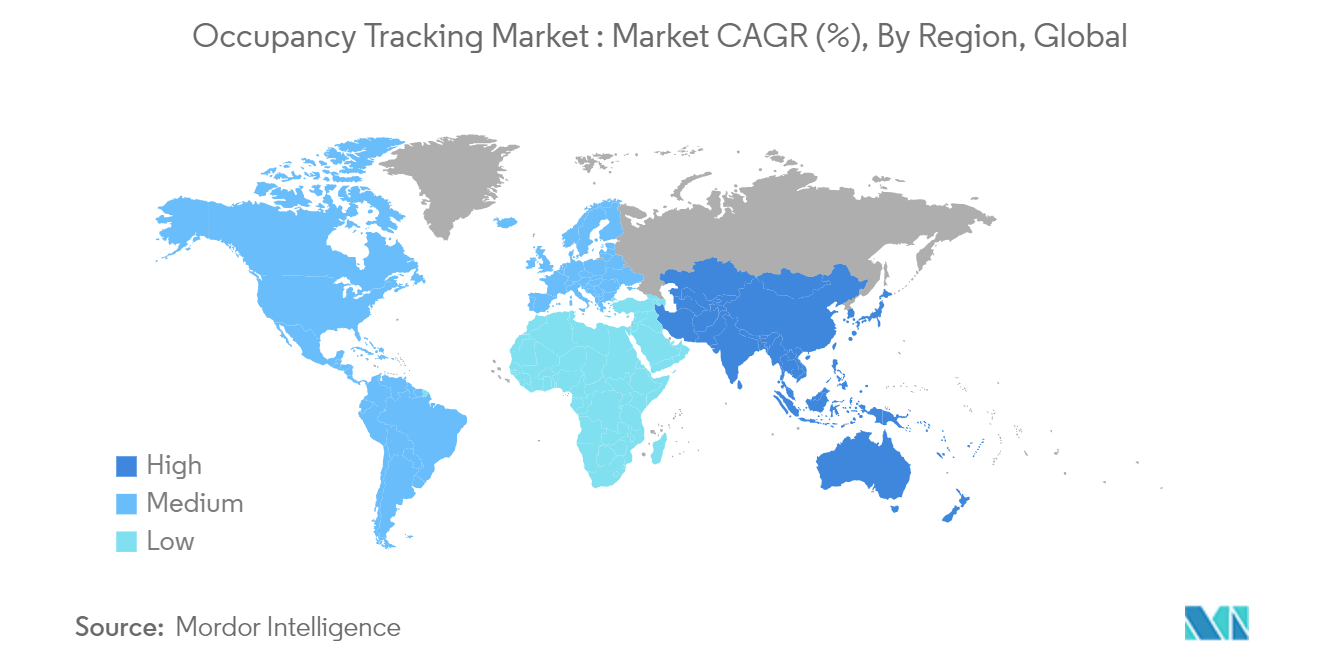
Occupancy Tracking Industry Overview
The occupancy tracking market is significantly competitive, with several major players performing in the market and taking steps to expand their market footprint by focusing on product diversification. The players strengthen their product portfolio by adopting several strategies, including new product developments, partnerships, mergers, additions, etc., to gain a competitive edge over other players.
In January 2023, indie Semiconductor, an Autotech solutions innovator, announced a partnership with Seeing Machines, one of the leading computer vision technology companies, to complement the development of advanced vision processors for driver and vehicle occupant monitoring.
In November 2022, Occupancy technology company Occuspace announced its expansion into several colleges and universities in the U.S. and Canada to report real-time and historical space usage data for campus buildings to anyone using their Waitz mobile app, which was especially useful to students seeking places to study.
In August 2022, Fusion92, a Chicago-based marketing innovation firm with offices in Chicago, Detroit, and Austin, partnered with Occuspace, a significant occupancy monitoring technology firm, to provide innovative analytics solutions that assist retailers in better understanding foot traffic data, closing the media attribution loop, uncovering new brick-and-mortar insights, and improving the customer experience.
Occupancy Tracking Market Leaders
-
Honeywell International
-
Eaton Corporation
-
Schneider Electric
-
Legrand Inc.
-
Leviton Manufacturing Company
*Disclaimer: Major Players sorted in no particular order
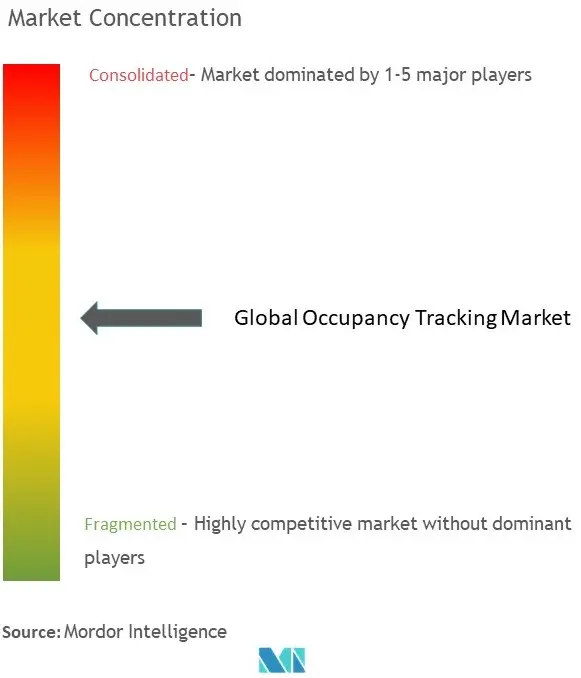
Occupancy Tracking Market News
- May 2023 - Honeywell and Arcadis announced a partnership to offer tools and services to help optimize energy use and carbon emissions in commercial buildings globally. Honeywell offers smart-building technologies that utilize machine learning and artificial intelligence (ML/AI)-enabled software to enhance control systems with sensor-driven analytics, occupancy tracking, and predictive maintenance.
- March 2023 - AVUITY, a significant provider of innovative workplace technology and space utilization solutions, announced the release of its most recent line of sensors, which are expected to revolutionize the industry due to their exceptional accuracy and efficiency. The latest VuAI sensors incorporate cutting-edge technology and advanced algorithms to provide unrivaled real-time data collection and analysis precision. These cutting-edge sensors can detect occupancy and utilization as well as minute variations in temperature, light, noise, and humidity.
Occupancy Tracking Market Report - Table of Contents
1. INTRODUCTION
- 1.1 Study Assumptions and Market Definition
- 1.2 Scope of the Study
2. RESEARCH METHODOLOGY
3. EXECUTIVE SUMMARY
4. MARKET INSIGHTS
- 4.1 Market Overview
-
4.2 Industry Attractiveness - Porter's Five Forces Analysis
- 4.2.1 Bargaining Power of Suppliers
- 4.2.2 Bargaining Power of Buyers
- 4.2.3 Threat of New Entrants
- 4.2.4 Threat of Substitutes
- 4.2.5 Intensity of Competitive Rivalry
- 4.3 Industry Value Chain Analysis
- 4.4 Assessment of Impact of COVID-19 on the Market
5. MARKET DYNAMICS
-
5.1 Market Drivers
- 5.1.1 Increasing Need for Space Utilization and Optimization in Buildings
- 5.1.2 Rising Demand for Energy-efficient Devices
-
5.2 Market Challenges
- 5.2.1 Lack of Awareness Regarding the Benefits of Occupancy Tracking
6. MARKET SEGMENTATION
-
6.1 By Offering Type
- 6.1.1 Hardware
- 6.1.2 Software
- 6.1.3 Services
-
6.2 By Building Types
- 6.2.1 Office
- 6.2.2 Retail
- 6.2.3 Education
- 6.2.4 Healthcare
- 6.2.5 Hotels& Restaurants
- 6.2.6 Institutional/Assembly
- 6.2.7 Warehouse
- 6.2.8 Transport
-
6.3 By Geography
- 6.3.1 North America
- 6.3.2 Europe
- 6.3.3 Asia-Pacific
- 6.3.4 Latin America
- 6.3.5 Middle East and Africa
7. COMPETITIVE LANDSCAPE
-
7.1 Company Profiles
- 7.1.1 Honeywell International
- 7.1.2 Eaton Corporation
- 7.1.3 Schneider Electric
- 7.1.4 Legrand Inc.
- 7.1.5 Leviton Manufacturing Company
- 7.1.6 Philips Ltd
- 7.1.7 Hubbell Building Automation Inc.
- 7.1.8 Johnson Controls GmbH
- 7.1.9 Lutron Electronics, Inc.
- 7.1.10 General Electric
- 7.1.11 Acuity Brands
- *List Not Exhaustive
8. INVESTMENT ANALYSIS
9. FUTURE OF THE MARKET
** Subject To AvailablityOccupancy Tracking Industry Segmentation
Occupancy monitoring systems identify underutilized and overcrowded areas, inform better decisions regarding space allocation, and provide the actual data business decision-makers need when considering downsizing their premises. For example, to track how many people are in a building and where they are within the building.
The studied market is segmented by hardware, software, and service offering types among various building types such as office, retail, education, healthcare, hotels and restaurants, institutional/assembly, warehouse, and transport in multiple geographies. The impact of COVID-19 on the market and impacted segments is also covered under the scope of the study. Further, the disturbance of the factors affecting the market's expansion in the near future has been covered in the study regarding drivers and restraints. The market sizes and forecasts are provided in terms of value (USD) for all the above segments.
| By Offering Type | Hardware |
| Software | |
| Services | |
| By Building Types | Office |
| Retail | |
| Education | |
| Healthcare | |
| Hotels& Restaurants | |
| Institutional/Assembly | |
| Warehouse | |
| Transport | |
| By Geography | North America |
| Europe | |
| Asia-Pacific | |
| Latin America | |
| Middle East and Africa |
Occupancy Tracking Market Research Faqs
How big is the Occupancy Tracking Market?
The Occupancy Tracking Market size is expected to reach USD 1.21 billion in 2024 and grow at a CAGR of 29.80% to reach USD 4.43 billion by 2029.
What is the current Occupancy Tracking Market size?
In 2024, the Occupancy Tracking Market size is expected to reach USD 1.21 billion.
Who are the key players in Occupancy Tracking Market?
Honeywell International, Eaton Corporation, Schneider Electric, Legrand Inc. and Leviton Manufacturing Company are the major companies operating in the Occupancy Tracking Market.
Which is the fastest growing region in Occupancy Tracking Market?
Asia Pacific is estimated to grow at the highest CAGR over the forecast period (2024-2029).
Which region has the biggest share in Occupancy Tracking Market?
In 2024, the Asia Pacific accounts for the largest market share in Occupancy Tracking Market.
What years does this Occupancy Tracking Market cover, and what was the market size in 2023?
In 2023, the Occupancy Tracking Market size was estimated at USD 0.93 billion. The report covers the Occupancy Tracking Market historical market size for years: 2019, 2020, 2021, 2022 and 2023. The report also forecasts the Occupancy Tracking Market size for years: 2024, 2025, 2026, 2027, 2028 and 2029.
Occupancy Tracking Industry Report
Statistics for the 2024 Occupancy Tracking market share, size and revenue growth rate, created by Mordor Intelligence™ Industry Reports. Occupancy Tracking analysis includes a market forecast outlook to for 2024 to 2029 and historical overview. Get a sample of this industry analysis as a free report PDF download.

